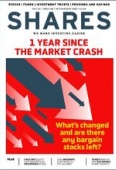Archived article
Please note that tax, investment, pension and ISA rules can change and the information and any views contained in this article may now be inaccurate.
Blame game won’t stop the next Gamestop

Today’s (18 February) Congressional hearing in Washington into what happened with shares in Gamestop should make for fascinating listening.
A host of luminaries – including Vlad Tenev from Robinhood, Ken Griffin from Citadel, Steve Huffmann from Reddit, high-profile retail trader Keith Gill (‘Roaring Kitty’) and Gabe Plotkin of Melvin Capital, the hedge fund pummelled by Gamestop’s meteoric, if short-lived, surge – will all testify on Capitol Hill. Meanwhile, the American markets’ key regulator, the Securities and Exchange Commission, is planning to produce a report to see what lessons can be learned.
This column’s suspicion is that tighter regulation will follow – but not yet. History suggests that will only come after a deeper, longer, bear market across equities more generally that inflicts pain on a far greater number of investors and traders than the shenanigans involving Gamestop.
That is when the real hunt for scapegoats and the apportionment of blame will begin, with hedge funds probably top of the list – even if, as Edward Chancellor writes in his excellent history of financial speculation Devil Take the Hindmost: ‘Although short-sellers are invariably blamed for the collapse of stock markets, the problem is really caused by long-only buyers during the preceding bull market, who push stocks to unsustainable levels. No government has yet seen fit to ban stock purchases during a stock market bubble.’
EYE OF THE BEHOLDER
The tricky bit is defining a bubble. Former US Federal Reserve chairman Alan Greenspan went on the record as saying bubbles could only be spotted after the fact, after they have burst – by which time it was too late. Several current Fed officials, including chair Jay Powell, are now vigorously rebutting arguments that fresh bubbles are sprouting up everywhere, from Gamestop to Special Purpose Acquisition Companies (SPACs), to new company flotations and beyond.
One person’s bubble is another’s bull market and profit opportunity (as owners of bitcoin will tell you). One way to judge whether are in a bubble (or not) is to follow the classic cycle of bubbles outlined by Charles P. Kindleberger in his magisterial history of financial mayhem, Manias, Panics and Crashes. The details of each episode may change but human behaviour clearly does not and the running order is consistent. Investors can therefore decide where in this cycle we might be right now.
– The starting points are cheap credit and the prospect of a fabulous, new investment opportunity that offers the prospect of big gains (anything from tulip bulbs to railroads to Japanese property to technology stocks will do if the mood is right).
– Initial price rises then catch the attention of newcomers, as ‘fear of missing out’ (FOMO) starts to gather steam.
– Investment profits go into orbit and fresh money is attracted, often in the form of borrowed cash.
– Copy-cats and imitators appear and more credit becomes available as asset prices keep rising.
– Trouble starts. Insiders start to lock in their profits by selling at elevated prices. This leaves the last investors to get in holding the bag. Prices initially correct but then rally as loyal supporters ‘buy on the dips’.
– A new offering goes wrong and the queue of copy-cat flotations and management teams looking to sell their stock on a secondary basis lengthens. The supply of paper begins to outstrip demand and asset prices fail to reach their previous peaks.
– Then comes a scandal, in the form of a fraud or bankruptcy. Investors realise they have been had and their money has gone.
– Fear and revulsion replace greed, asset prices collapse as investors scramble to cut their losses and the blame game begins.
That takes us back to whether regulation is the only answer. This above potted history of every bubble from Dutch tulips in the 1620s through to American housing in 2007 would suggest not. Every meltdown has prompted regulation of some kind – from Sir John Banham’s Act in 1734 in the UK through to Dodd-Frank Act in 2010 in America – but to no ultimate avail.
ACTION REPLAY
This is because human behaviour does not change (and the memory of prior disasters ultimately fades). As Warren Buffett once tartly put it: ‘People start being interested in something because it’s going up, not because they understand it, or anything else. But the guy next door, who they know is dumber than they are, is getting rich and they aren’t. And their spouse is saying, can’t you figure it out, too? It is so contagious. It’s a permanent part of the system.’
Everyone will have their own views on whether we are in bubble territory or not and if so, in which asset classes. But if we are in a bubble, then investors face an invidious choice: either to be wrong by taking profits too early or to be wrong by trying to get out too late.
How investors go about addressing that challenge will be a matter of personal taste, financial circumstance and risk appetite but industry professionals will generally take the latter option (at least based upon this column’s experiences as an equity analyst at a leading investment bank for 12 years).
It is less obvious that you have erred (and less career-threatening) if you go over the cliff with everyone else, instead of standing aside as asset prices surge higher. Plus, even if a forecast of imminent doom is right, no thanks are offered, only blame to the Cassandras who sowed the first seeds of doubt.
Important information:
These articles are provided by Shares magazine which is published by AJ Bell Media, a part of AJ Bell. Shares is not written by AJ Bell.
Shares is provided for your general information and use and is not a personal recommendation to invest. It is not intended to be relied upon by you in making or not making any investment decisions. The investments referred to in these articles will not be suitable for all investors. If in doubt please seek appropriate independent financial advice.
Investors acting on the information in these articles do so at their own risk and AJ Bell Media and its staff do not accept liability for losses suffered by investors as a result of their investment decisions.

 magazine
magazine










